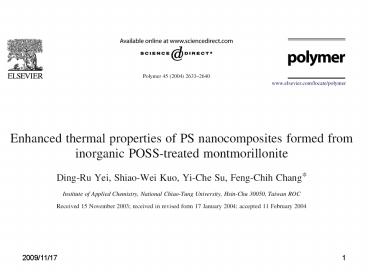Abstract
1 / 25
Title: Abstract
1
(No Transcript)
2
- Abstract
- We have prepared polystyrene/clay nanocomposites
using an emulsion polymerization technique. - The nanocomposites were exfoliated at up to a 3
wt content of pristine clay relative to the
amount of polystyrene (PS). - We used two different surfactants for the
montmorillonite the aminopropylisobutyl
polyhedral oligomeric silsesquioxane (POSS) and
the ammonium salt of cetylpyridinium chloride
(CPC).
3
- Both surfactants can intercalate into the layers
of the pristine clay dispersed in water prior to
polymerization. - Although the d spacing of the POSS-intercalated
clay is relatively smaller than that of the
CPC-intercalated clay, PS more easily
intercalates and exfoliates the POSS-treated clay
than the CPC-treated clay. - IR spectroscopic analysis further con?rms the
intercalation of POSS within the clay layers.
4
- We used X-ray diffraction (XRD) and transmission
electron microscopy (TEM) to characterize the
structures of the nanocomposites. - The nanocomposite prepared from the clay treated
with the POSS containing surfactant is
exfoliated, while an intercalated clay was
obtained from the CPC-treated surfactant. - The molecular weights of polystyrene (PS)
obtained from the nanocomposite is slightly lower
than the virgin PS formed under similar
polymerization conditions.
5
- The value of Tg of the PS component in the
nanocomposite is 8 C higher than the virgin PS
and its thermal decomposition temperature (21 C
) is also higher signi?cantly. - The presence of the POSS unit in the MMT enhances
the thermal stability of the polystyrene. - Keywords Montmorillonite Nanocomposites
Polystyrene
6
- 1. Introduction
- Nanoclay-?lled polymeric systems offer the
prospect of greatly improving many of the
properties of their mother polymers. - In the recent literature, there have been
reports of nanoclay-?lled polymeric systems that
display signi?cant improvements in tensile and
thermal properties 19, heat distortion
temperatures 16, and resistance to ?ammability
12 and reduced permeability to small molecules
5,10,11 and reduced solvent uptake 13.
7
- The nanocomposite typically comprises the
organically modi?ed clay and the mother polymer. - Montmorillonite (MMT), which is an
aluminosilicate mineral with sodium counterions
present between the layers, is the most commonly
used clay. - The space between these clay layers is referred
to as the clay gallery. - To make this inorganic clay compatible with
organic polymers, the sodium counterions are
usually ion-exchanged with an organic ammonium or
salt to convert the material into hydrophobic
ammonium-treated clays.
8
- PS/clay nanocomposites were prepared through
emulsion polymerization by suspending the
surfactant-treated clay in styrene monomer. - IR spectroscopic analysis con?rmed the existence
of POSS in the intercalated clay samples. - We used both X-ray diffraction (XRD) and
transmission electron microscopy (TEM) to
characterize the clay structure. - The properties of these PS/clay nanocomposites
were characterized by thermogravimetric analysis
(TGA), differential scanning calorimetry (DSC),
and gel permeation chromatography (GPC).
9
- 2. Experimental
- 2.1. Materials
- Most of chemicals used in this study, including
monomeric styrene, chemically pure acetone,
methanol, tetrahydrofuran, and potassium
hydroxide (KOH) were acquired from the Aldrich
Chemical Co. - 2.2. Preparation of CPC-modi?ed clays
- The organically modi?ed clay was obtained by
combining sodium montmorillonite (5 g) and the
desired quantity (1, 1.5, 2, or 2.5 g) of the
ammonium salt (CPC), as previously described
19.
10
- 2.3. Preparation of POSS-modi?ed clays
- The prewashed clay (1 g) and water (50 ml) were
placed into a 100 ml two-neck round-bottom ?ask
and stirred continuously for 4 h. - POSS (0.4 g) in THF (1 ml) was placed into
another ?ask and then 10 hydrochloric acid (1
ml) was added and then stirring for 1 h. - This POSS solution was then added into the
suspended clay and the mixture was stirred
overnight. - The mixture was ?ltered, washed several times
with deionized water, and then dried overnight in
a vacuum oven at room temperature.
11
- 2.5. Instrumentations
- IR spectroscopy was performed on a Nicolet Avatar
320 FTIR Spectrophotometer, 32 scans were
collected at a spectral resolution of 1 cm-1. - Infrared spectra of the organic-modi?ed clay
were obtained using the conventional KBr pellet
method. - XRD spectra were collected on an M18XHF-SPA X-ray
diffraction instrument (MacScience Co., Japan),
using Co K? radiation Braggs law (?2dsin ?)
was used to calculate the spacing.
12
- TEM images of the composites were obtained at 100
kV using a Hitachi H-7500 Electron Microscope. - Thermogravimetric analyses were performed on a TA
Instruments Thermal Analyzer under a 40 ml/min
?ow of nitrogen gas at a scan rate of 20 C /min
from 30 to 800 C . - A Du-Pont (DSC-9000) differential scanning
calorimeter (DSC) was used to measure the glass
transition temperature (Tg) of the PS/clay.
13
3. Results and discussion
- 3.1. X-ray diffractions
- We used XRD to characterize the layered
structures of the modi?ed clays and polymer/clay
nanocomposites, since changes in 2? indicate
changes in the gallery distance of the clay. - Fig. 1 shows XRD patterns of organic-modi?ed
clays containing different CPC/clay ratios.
14
(No Transcript)
15
- The basal space indicates the interlayer spacing
of the silicate layers, which is calculated from
the peak position using the Bragg equation. - The pristine clay has this peak at 6.94 , which
corresponds to a basal space of 1.26 nm. - The insertion of the CPC surfactant between the
galleries of the clay increases the d spacing as
the CPC/clay ratio increases.
16
- When the CPC/clay ratio is greater than 0.4, the
d spacing remains constant, which implies that
oversaturation of the surfactant has occurred. - This result indicates that the CPC surfactant
becomes successfully intercalated into the
galleries of the clay nanoparticles.
17
PS
18
(No Transcript)
19
(No Transcript)
20
(No Transcript)
21
(No Transcript)
22
(No Transcript)
23
(No Transcript)
24
(No Transcript)
25
(No Transcript)































